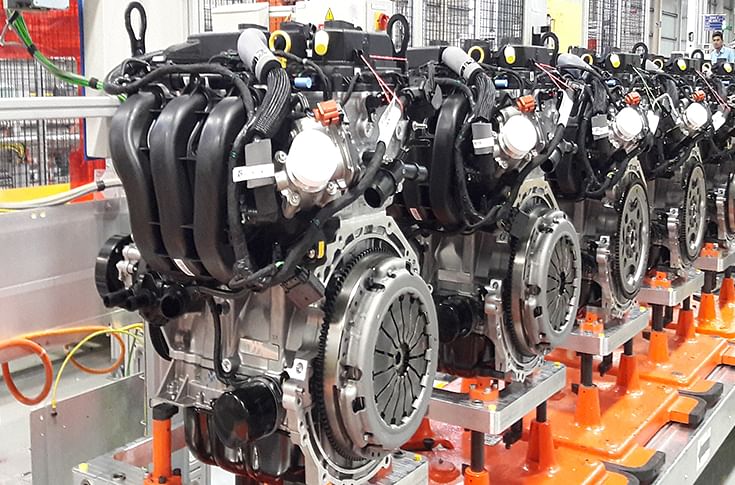Tata Motors boosting capacity to sell half a million cars annually
Record sales and robust demand across product lines have encouraged Tata Motors to increase capacity which includes a likely acquisition of Ford India’s Sanand factory.
Tata Motors has beaten all odds by posting record car sales despite the ravages of the pandemic and the semiconductor shortages that have caused worldwide disruptions to production.
“The last two years have been difficult for the auto industry and seeing Tata Motors grow two-and-a -half times is something that makes me proud,” said Shailesh Chandra, Managing Director, Tata Motors Passenger Vehicles and Tata Passenger Electric Mobility.
He made these comments whilst accepting the Manufacturer of the Year award on behalf of the company at the recent Autocar Awards 2022 ceremony. Ever since the pandemic engulfed the world in early 2020, Tata Motors has bucked the trend and outpaced the industry with zooming sales from 131,197 units in FY 20 to a projected 350,000 units in FY 22 based on the current sales momentum.
And now, with the dark clouds of the pandemic fast abating and the supply crunch of semiconductors easing, the company is gearing up for even more growth in a bullish market forecast to have clear skies ahead. According to industry sources, encouraged by strong demand across its product lines, Tata Motors has drawn up aggressive plans to produce over 500,000 cars a year. It is targeting sales of around 40,000 cars per month in the first few months of the next fiscal, rising to 50,000 units a month on the back of the new launches, additional variants and facelifts later in the year.
Tata Motors is believed to be focusing on the Nexon, Altroz and Punch as the main volume drivers since these are the most profitable models in its portfolio. Suppliers have been told to gear up for volumes of 15,000 Nexons per month of which over 3,000 are likely to be the all-electric variant. The long range Nexon EV, due in the first quarter of the next fiscal, is expected to further boost demand for Tata Motors' (and India’s) best-selling EV.
The company also has an ambitious target to sell over 10,000 units of the Altroz and Punch each per month. The Altroz has finally got an automatic option which should enhance demand whilst the Punch is making strong inroads into the lower end of the compact SUV segment, where there is not too much competition. Whatever balance capacity remains will be used for the Harrier/Safari and Tigor/Tiago models.
Interestingly, Tata Motors has no all-new models planned next fiscal except for the Nexon Coupe which in essence is a derivative of the current Nexon. The company appears to have prioritised investment in capacity over product development and is close to acquiring Ford’s Sanand plant.
Sanand beckons
The Sanand plant will augment Tata Motors capacity by an additional 240,000 units to 720,000 units per annum.

File shots of Ford's Sanand plant
At present, the company has a capacity of 480,000 units across multiple plants. The Nexon is produced at the Ranjangaon plant near Pune which is part of a manufacturing joint venture with Stellantis.
The Pimpri plant at Pune is home to the Harrier, Safari, Altroz and Punch while Tata’s own facility at Sanand (which was originally planned for the Nano) rolls out the Tiago and Tigor compact cars.
Once the Ford deal is sealed, the American automaker’s Sanand unit will, in all likelihood, be earmarked for new models across electric, CNG and the internal combustion engines. Tata is unlikely to produce its own engines at Ford’s Sanand plant as Ford has already indicated that it will retain the engine manufacturing business at the Sanand facility for exports. Hence, once the Tata takeover happens, its operations will be confined to the automobile production line with engines set aside for Ford. It now remains to be seen how quickly the transfer of ownership happens even while sources reiterate that the state government will ensure a speedy transition especially with the assembly elections scheduled to be held this year. “Sending out a positive message of being business-friendly and ensuring jobs will tilt the scales in favour of the present BJP regime in Gujarat,” they say.
Incidentally, it was Gujarat which literally laid out the red carpet for Tata Motors in 2008 when the company decided to slam the brakes on the Nano project in West Bengal. The government wasted little time in offering Sanand as an alternative location and this became home to the people’s car.
Since then, Gujarat has attracted more brands to the state and just last week, Maruti-Suzuki announced an investment of Rs 10,440 crore in EV and battery manufacturing.
As for Ford, it still has its other facility at Maraimalainagar near Chennai to reckon with where the Tamil Nadu government is anxious to find a buyer. In fact, recent meetings between the Tata Group Chairman, N. Chandrasekaran and Chief Minister MK Stalin sparked speculation that the company was considering this plant but it was never an option for Tata Motors.

“The Maraimalainagar plant does not have the desired flexibility in manufacturing and can only make two models which ruled it out,” said a Ford source. The Sanand facility in comparison is a state-of-the-art manufacturing facility which “Tata Motors could get for a bargain,” said the source.
However, the Sanand plant too poses its own set of challenges which is why Tata Motors has not been in a rush to snap it up. Built to Ford’s global standards, it has a body shop with over 90 percent robotisation. Whilst this level bodes well for quality and productivity, sources say that it requires “a minimum volume of 100,000 units a year for operational breakeven”.
However, given the strong pull on current products and a slew of EVs planned in the coming years, Tata Motors is confident about mopping up the big jump in capacity the Sanand plant brings. There’s no doubt that Tata Motors is on a roll. It overtook Hyundai as the number two player in December 2021 and given the company’s sales trajectory this decade could see the stakes shift in favour of Tata Motors as a serious rival to market leader Maruti Suzuki.
Read More
Maruti Suzuki, Toyota India’s first EV to be a global midsize SUV
Tatas sign definitive agreement to acquire Ford India’s Sanand plant for Rs 725 crore
RELATED ARTICLES
JSW MG Motor India confident of selling 1,000 M9 electric MPVs in first year
The 5.2-metre-long, seven-seater luxury electric MPV, which will be locally assembled at the Halol plant in Gujarat, wil...
Modern Automotives targets 25% CAGR in forged components by FY2031, diversifies into e-3Ws
The Tier-1 component supplier of forged components such as connecting rods, crankshafts, tie-rods, and fork bridges to l...
VinFast’s second plant in Vietnam goes on stream ahead of India factory
Vietnamese EV maker’s second plant in its home market, which has a 200,000 EVs-per-annum capacity, will focus on produci...





 21 Mar 2022
21 Mar 2022
 34584 Views
34584 Views





 Autocar Professional Bureau
Autocar Professional Bureau




